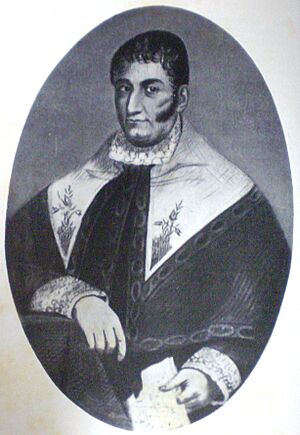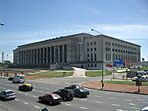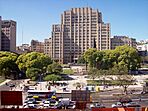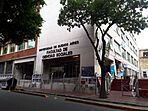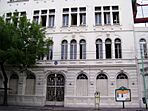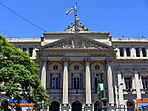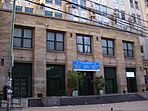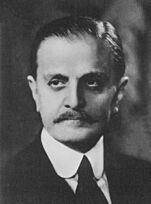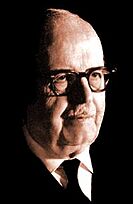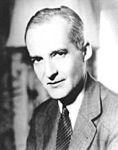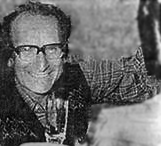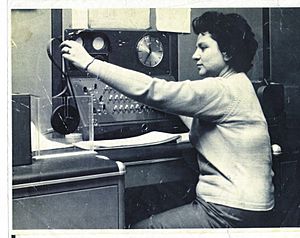University of Buenos Aires facts for kids
|
Universidad de Buenos Aires
|
|
 |
|
| Motto | Argentum virtus robur et studium (Latin) |
|---|---|
|
Motto in English
|
Argentine virtue is strength and study |
| Type | Public |
| Established | 1821 |
| Budget | AR$ 541,780 million (US$451 million; 2024) |
| Rector | Ricardo Gelpi |
| Vice Rector | Emiliano Yacobitti |
|
Academic staff
|
30,850 (2024) |
| Students | 350,000 (2024) |
| Undergraduates | 297,639 (2004) |
| Postgraduates | 30,000 (2018) |
| Location |
,
Argentina
|
| Campus | Urban |
| Colors | |
 |
|
| University rankings | |
|---|---|
| Global – Overall | |
| ARWU World | 201-300 (2022) |
| CWUR World | 382 (2023) |
| CWTS World | 416 (2023) |
| QS World | =95 (2024) |
| USNWR Global | =426 (2022-23) |
| Regional – Overall | |
| QS Latin America | 9 (2023) |
| USNWR Latin America | 7 (2022-23) |
The University of Buenos Aires (Spanish: Universidad de Buenos Aires, UBA) is a large public research university located in Buenos Aires, Argentina. It is the second-oldest university in Argentina. It is also the largest university in the country, with many students.
UBA was started in 1821. It has educated 17 Argentine presidents. Four of Argentina's five Nobel Prize winners studied there. About 40% of Argentina's research comes from UBA.
Many students from other countries come to UBA. This is especially true for students studying for advanced degrees. About 4% of undergraduate students are from other countries. For postgraduate students, this number is 15%. The Faculty of Economic Sciences has the most international postgraduate students, at 30%. This faculty is known as a top business school.
The University of Buenos Aires has over 328,000 students. It is organized into 13 different faculties. It also runs 6 hospitals, 16 museums, and 13 science institutes. UBA also has 5 high schools, a cultural center, a cinema, and a symphony orchestra. It also runs Eudeba, which is Argentina's biggest university publishing company.
Since 1949, all undergraduate programs at UBA have been free. This is true for everyone, no matter where they are from. Money from postgraduate programs helps UBA offer free education to all.
Contents
History of UBA
How UBA Started
Unlike other big cities in the Spanish Colonial Americas, Buenos Aires did not have its own university. Other cities like Córdoba already had universities.
After Argentina became independent in 1816, people wanted a university in the capital. On August 12, 1821, the University of Buenos Aires was officially started. This happened by a decision from Governor Martín Rodríguez. Antonio Sáenz, a religious leader, became the first Rector.
In its early years, there was a debate. Some people wanted the university to be non-religious. Others wanted it to follow traditional religious teachings. To start strong, UBA combined existing schools. These included courses in math, drawing, and natural history. Law courses were also added. This allowed UBA to offer degrees in medicine and law right away.
Changes in the Mid-1800s
During the time of Juan Manuel de Rosas, students had to pay to attend. The number of students went down a lot. The government also cut money for the university. Professors were not paid, and some departments almost closed.
Things got better after Rosas left power in 1852. The new government wanted to improve the university. They saw higher education as important for the country's future.

In 1863, UBA started the Colegio Nacional de Buenos Aires. The Escuela Superior de Comercio followed in 1890. In 1869, the first twelve Argentine engineers graduated from UBA. They were called the "Twelve Apostles."
By 1909, UBA had also created new faculties. These included Agronomy and Veterinary Sciences. The university also started an institute for business and economic sciences.
In 1881, Buenos Aires became part of the national government. This made UBA a national university. During the 1880s, UBA made great progress in science. This was because leaders at the time believed in science. The 1880s also saw the first women graduates. These were Élida Passo (pharmacy) and Cecilia Grierson (medicine).
University Reform of 1918
Around 1900, Argentina became more prosperous. This meant that children of immigrants could go to university. In June 1918, students at the National University of Córdoba started a movement. They wanted universities to have more freedom. They also wanted leaders to be chosen by students and professors. This movement spread across Latin America.
The reform gave UBA and other public universities important features. These include shared leadership and democratically chosen leaders. These features are still in place today.
Mid-20th Century Changes
The university's shared leadership was stopped when Juan Domingo Perón became president in 1946. However, Perón's government also made public universities completely free. This happened in November 1949. This change allowed many more people to get a higher education. From 1935 to 1955, UBA's student numbers grew from 12,000 to 71,823.
The 1940s also saw new faculties created. These included the Faculty of Dentistry and the Faculty of Architecture and Urbanism.
In 1955, the university's freedom and shared leadership were brought back. But, some professors were forced to leave. More problems happened during the time of Juan Carlos Onganía. His government took control of universities. They also censored what could be taught. On July 29, 1966, students protested. Government forces entered UBA buildings. They removed students and professors by force. This event is known as the Night of the Long Batons.
After the Night of the Long Batons, over 400 people were arrested. Many laboratories and libraries were damaged. Hundreds of professors were fired or left Argentina.
Late 20th Century to Today
In 1973, Juan Domingo Perón returned to power. A new law in 1974 gave universities more freedom. However, Perón's wife, Isabel Perón, later appointed a new leader for UBA. This leader caused many professors to be fired. Some students also went missing.
After a government takeover in 1976, things got worse. Professors and students faced danger. Universities were watched closely. The government censored research and what was taught. Thousands of books were burned. Entrance exams were brought back, and free education was stopped.
When democracy returned in 1983, UBA's freedom was restored. In 1985, UBA started the Ciclo Básico Común (CBC). This is a set of basic subjects all students must pass to join UBA. It replaced the old entrance exams. In the same year, the Faculty of Psychology was created.
Also in 1985, UBA started a program for people in federal prisons. This program, UBA XXII, allows them to study at the university. In 1988, the Faculty of Social Sciences was created. This is UBA's newest faculty.
How UBA is Organized
The University of Buenos Aires has thirteen self-governing faculties. These faculties offer many different courses. UBA also manages the Ciclo Básico Común (CBC). This is a set of subjects all students must pass to join any course at UBA. It replaced entrance exams in 1985.
UBA does not have one main campus. Its buildings are spread out across Buenos Aires. Some are also in the wider Buenos Aires area. The Ciudad Universitaria (University City) is the closest thing to a main campus. It is located by the Río de la Plata river. It houses the Faculty of Exact and Natural Sciences and the Faculty of Architecture, Design and Urbanism.
The faculties are:
- Faculty of Agronomy (FAUBA)
- Faculty of Architecture, Design and Urbanism (FADU)
- Faculty of Economic Sciences (FCE)
- Faculty of Exact and Natural Sciences (FCEN)
- Faculty of Medical Sciences (FMED)
- Faculty of Social Sciences (FSoc)
- Faculty of Veterinary Sciences (FVET)
- Faculty of Law (FDUBA)
- Faculty of Pharmacy and Biochemistry (FFyB)
- Faculty of Philosophy and Letters (FFyL)
- Faculty of Engineering (FIUBA)
- Faculty of Dentistry (FOUBA)
- Faculty of Psychology (PSI)
The Faculty of Economic Sciences is the largest faculty. It has over 36,000 students. In recent years, the Faculty of Medicine has attracted the most new students.
Besides the faculties, UBA also manages:
- 6 hospitals
- 16 museums
- 13 scientific institutes
- 5 high schools (including Colegio Nacional de Buenos Aires and Escuela Superior de Comercio Carlos Pellegrini)
- The Centro Cultural Ricardo Rojas
- The Cosmos Cinema
- The University of Buenos Aires Symphony Orchestra
- Eudeba, Argentina's largest university press.
How UBA is Managed
Since the 1918 University Reform, UBA has been run by shared leadership. The university is led by the Rector and the Consejo Superior (Superior Council). The Superior Council has 29 members. These include the rector, the deans of the thirteen faculties, and representatives for professors, students, and graduates.
All leaders and representatives are chosen every four years. Professors, students, and graduates vote in these elections. Each of the thirteen faculties also has its own elected dean and council. The Rector is chosen by the University Assembly. This assembly includes members from the Superior Council and all faculty councils. Since 2022, Ricardo Gelpi has been the Rector of UBA.
Students in all faculties have their own student unions. These unions are also chosen by students. They are part of the Federación Universitaria de Buenos Aires (FUBA). FUBA is part of the larger Argentine University Federation.
UBA's Reputation
The QS World University Rankings placed the University of Buenos Aires as 66th in the world in 2021. This shows it is a highly respected university globally.
Famous People from UBA
Many famous people have studied at UBA. These include four of Argentina's five Nobel Prize winners. Seventeen presidents of Argentina also studied there. Many other notable people in science, business, literature, and arts are UBA alumni.
Leaders and Politicians
Seventeen Argentine presidents studied at UBA. These include Hipólito Yrigoyen, Marcelo T. de Alvear, and Raúl Alfonsín. Most of them studied law. Alberto Fernández, a recent president, taught criminal law at UBA for many years.
Many other political leaders also studied at UBA. This includes Ernesto "Che" Guevara, who studied medicine. Several government ministers also got their degrees from UBA.
José Pedro Montero, who was the 27th president of Paraguay, also studied at UBA.
Law Experts
Many important legal experts studied at the UBA Faculty of Law. Carlos Saavedra Lamas, a Nobel Peace Prize winner in 1936, earned his law degree at UBA. He also served as the university's rector. Luis Moreno Ocampo, a chief prosecutor at the International Criminal Court, graduated in 1978. Several judges of Argentina's Supreme Court also studied at UBA.
Medical Professionals
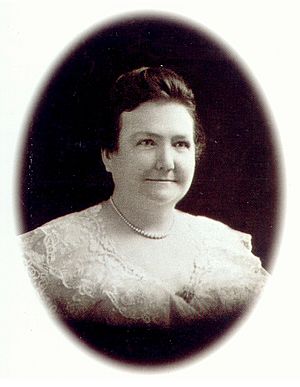
UBA has produced many important people in medicine. Two Nobel Prize in Physiology or Medicine winners studied at UBA: Bernardo Houssay (1947) and César Milstein (1984).
Élida Passo was the first Argentine woman to be a pharmacist. She earned her UBA degree in 1885. Cecilia Grierson was the first woman to get a medical degree in Argentina. She did so at UBA in 1889. Other famous doctors from UBA include Ramón Carrillo and Luis Agote.
Business Leaders
Many successful business people studied at UBA. These include oil tycoons Alejandro Bulgheroni and Carlos Bulgheroni. Also, agri-business executive Andrea Grobocopatel and sugar magnate Robustiano Patrón Costas.
Many founders of successful startup companies also came from UBA. Startups founded by UBA alumni raised the most money in Latin America in 2020.
Engineer Horacio Anasagasti created Argentina's first car. He graduated from UBA's Faculty of Engineering in 1902.
Scientists and Mathematicians
Many important scientists in different fields studied at UBA. Many also taught and did research there. Luis Federico Leloir, Argentina's first Nobel Prize in Chemistry winner, studied at UBA. He discovered how lactose is processed in the body.
UBA has also produced many important biologists. These include Irene Schloss and Viviana Alder, who study Antarctic marine life. Patricia Ortúzar, a geographer, also got her degree from UBA.
Mathematicians from UBA include Luis Caffarelli, known for his work on equations. Alicia Dickenstein is known for her work on geometry and its use in biology.
Other famous UBA scientists include computer scientist Cecilia Berdichevsky. Also, physicist Juan Martín Maldacena and molecular biologist Alberto Kornblihtt.
Thinkers and Social Scientists
UBA has produced many important thinkers in social science and philosophy. Raúl Prebisch, who created the Prebisch–Singer hypothesis, studied economics at UBA. Social anthropologist Esther Hermitte also studied at UBA.
Political scientist Guillermo O'Donnell studied law at UBA. He is a major influence in Argentine political science. Sociologist Pilar Calveiro also started her studies at UBA.
Architects
Many famous architects, both in Argentina and worldwide, studied at UBA. Clorindo Testa, a pioneer of the brutalist style in Argentina, graduated from UBA's Faculty of Architecture in 1948. Alberto Prebisch, a rationalist architect, also graduated from UBA. He later became a dean there.
Artists, Writers, and Filmmakers
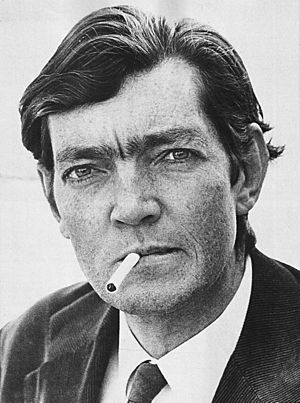
Writers linked to UBA include novelist Julio Cortázar. He was one of the founders of the Latin American Boom in literature. Cortázar started a philosophy degree at UBA. Poet and critic Jorge Fondebrider studied literature at UBA. He also directed UBA's cultural center.
Other writers educated at UBA include Esther Vilar and poet Alejandra Pizarnik. Filmmaker Juan Cabral also began his studies at UBA.
UBA Media
The university has its own radio station, Radio Universidad de Buenos Aires. It broadcasts on FM 87.9 MHz. Its programs are mostly about academic and social topics. It started on December 20, 2005. Its motto is El saber está en el aire ("Knowledge is in the air").
See also
 In Spanish: Universidad de Buenos Aires para niños
In Spanish: Universidad de Buenos Aires para niños
- Education in Argentina
- List of Argentine universities
- Argentine university reform of 1918
- Science and technology in Argentina


